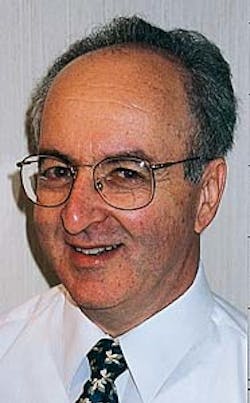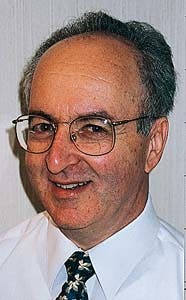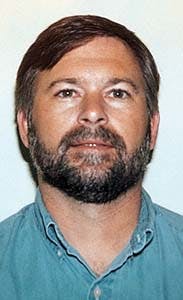Near-bit resistivity tool calculates dip real time
Richard A. Rosthal, Ted BornemannFormation dip can now be estimated real time using a specially designed logging-while-drilling (LWD), near-bit resistivity tool. The tool is designed to screw directly into the bit, but can be run anywhere in the drillstring.
Anadrill
HoustonJim R. Ezell
Exxon Corp.
HoustonJon R. Schwalbach
Exxon Corp.
Thousand Oaks, Calif.
As the tool rotates, a pair of magnetometers measures tool orientation relative to the earth's magnetic field, allowing properly orientated resistivity images and gamma ray measurements to be recorded.
New computational methods allow the near-bit resistivity tool to perform apparent dip calculations during the drilling process. The tool calculates apparent dip direction, dip magnitude, and a quality factor over intervals of 3 min. These data are transmitted to the surface and displayed as apparent and true dip.
Because local structural dip may differ from predictions that use large-scale maps or seismic sections, apparent dip calculations can be used to confirm the drilling plan or modify the drilling operation real time.
The method used to compute dip is fundamentally different from conventional dipmeter processing. Whereas conventional processing produces the highest degree of accuracy when bedding planes are nearly normal to the borehole, this new technique achieves the highest degree of accuracy when bedding planes are nearly parallel to the borehole. The technique does not work, however, when the bedding planes are perpendicular to the borehole.
Thus, this technique can be used to determine whether the borehole is moving up or down in relation to the bedding planes. An added advantage for this process is that it uses data acquired at a single instance, making it immune to any errors in the measurement of absolute depth.
Because depth errors can produce mistakes in the computation of dip, the method's immunity is especially important in the while-drilling environment, where depth control becomes more problematic than for wire line operations.
Real-time dip
Reservoir development is usually guided by structural interpretation obtained from seismic surveys. While seismic surveys provide continuous sections, they have poor resolution and rely upon assumptions concerning formation sonic velocities.As additional wells are drilled, reservoir geometry interpretations are refined as additional detailed measurements, including formation dip and acoustic velocity, become available.1 Dip data in particular can be utilized to recognize structures such as folds and faults and help in the interpretation of the depositional environment.
A number of wire line tools have been developed over the years to determine formation dip. Dipmeter tools with pad-mounted electrodes provide high-resolution electrical measurements from which formation dips can be computed.
In 1986, electrical imaging tools became available and are now commonly used for this purpose. It is now possible to determine dip with the near-bit resistivity LWD tool.1
The determination of dip can be calculated through conventional processing methods once resistivity images are downloaded from the tool on the rig floor. However, dip can also be calculated with a unique processing method that runs in the tool during the drilling process.
While these dips can be used for conventional structural and stratigraphic interpretation, obtaining formation dip in real-time offers a significant advantage over after-the-fact dipmeter analysis, particularly during the geo-steering process.
Real-time dip calculations make it possible to determine at what angle the well is cutting through the bedding planes. In a high angle or horizontal well, it is possible to accurately know whether the borehole is traveling up or down structure, all in real time.
This type of information can prevent unwelcome surprises by enabling a well course change to be made much earlier than formerly possible.
Theory
The near-bit resistivity tool was first introduced in 1993. 2 Unlike common LWD propagation tools that operate at frequencies from 400 kilohz to 2 megahz, the near-bit resistivity tool operates at 1,500 hz.Electric current patterns are similar to those of a focused laterolog. The tool makes five resistivity measurements: a single bit measurement that provides an initial indication of formation resistivity, and four high-resolution electrode measurements with different depths of investigation.
Toroidal transmitters force electric currents to run up and down the tool and drillstring. Arps first suggested this concept in 1967, and toroidal LWD tools were subsequently introduced in the mid-1980s.3-6
Electric currents are measured either with toroidal receivers that are sensitive to the total current in the string at that point, or with electrodes that are isolated from the tool's body, held at the same potential.
A toroidal receiver produces bit resistivity measurements that are sensitive to the average resistivity of the formation.
The near-bit resistivity tool has four electrodes consisting of three buttons and a ring that encircles the tool (Fig. 1 [75,935 bytes]). These electrodes are maintained at the same electrical potential as the surrounding drill collar. Electric currents that enter the electrodes are subsequently measured.
The button electrodes provide resistivity images and data used for real-time dip computations. They are mounted in a sleeve with a standoff of 3/16 in. for in-gauge boreholes.
The electric current that enters the buttons is inversely proportional to the resistivity of the formation immediately in front of them. As the tool rotates, magnetometers measure the tool's orientation and allow each of the button measurements to be placed at its proper orientation, thus creating a quantitative electrical image of the formation.
Methods for geological interpretation and dip determination have been previously developed by workers using these images.7-10 While the three buttons have different depths of investigation, configuring multiple buttons at different positions along the tool also permits real-time dip computations.11
Conventional dip processing algorithms were developed for dipmeters, devices that measure resistivity by pushing pads up against the borehole. Take for example a four-arm tool with one electrode mounted on each pad. Such a tool provides four micro-resistivity formation logs, measured at 90° from each other.
These curves should be very similar, except that they become depth-shifted whenever the angle between borehole and bedding is different than 90°. Determining these depth shifts is used to calculate dip. Conventional dipmeter processing involves finding the depth shifts between the electrode logs that maximize their cross-correlations. Considerable automatic dip processing using resistivity image logs follows the same approach, initiated by reducing the data image into a set of micro-resistivity curves.
The computed apparent dip is then converted into true dip using borehole deviation and azimuth measurements. Conventional dip computation methods are not possible in the LWD environment while the tool is downhole. The near-bit resistivity tool, like every LWD tool, makes measurements at some preprogrammed time interval.
As the tool makes an azimuthal scan of the formation, the subsurface depth position remains unknown. This information is known only at the surface and images and logs are produced by merging the data recorded in the tool, consisting of time-stamped data, with a file generated at the surface relating time and depth.
Because the tool does not know its location and cannot use conventional multidepth processing to compute dip, an alternative approach has been developed. Cross-correlation methods of dip determination do not require that the different measurements be identical, but only that they be similar enough to produce a good correlation.
The images produced by the three buttons are nearly identical and small differences do not present a problem in determining formation dip. The relative location of each button's image is fixed by the position of the buttons on the tool.
Thus, when an azimuthal scan is made from the three buttons, their relative positions are known. This new algorithm uses the relationship between the scans from the deep and medium button to determine the formation dip.
The idea of this algorithm is best understood by reference to Fig. 2 [144,992 bytes]. In order to avoid confusion, it is necessary to clarify the definition of apparent dip, which is the angle between the borehole and the normal to the bedding planes (Table 1 [55,965 bytes]).
Imagine a vertical borehole penetrating horizontal strata. The normal to the beds is parallel to the borehole and the apparent dip is therefore zero. In a horizontal well cutting through horizontal strata, the normal to the beds is perpendicular to the borehole and the apparent dip is 90°.
The upper part of Fig. 2 shows a borehole cutting through parallel horizontal beds at an angle. The medium button, so called because it has a medium depth of investigation, is located higher on the tool and investigates more of the upper blue bed and less of the lower green bed.
The deep button is located lower on the tool and investigates more of the lower bed and less of the upper one. The relationship between the size and location of the blue, red, and green sections allows the magnitude and direction of the formation dip to be calculated.
In the lower part of Fig. 2, the two scans are displayed unwrapped as images are usually presented. The scans are displaced to represent their position along the tool. The sine waves correspond to the upper and lower bed boundaries of the thin red colored bed in the center.
Not all of the two button scans correspond to the same portion of the formation. The formation at the top of the medium button scan does not appear on the deep button scan and the bottom of the deep button scan does not appear on the medium button scan.
The degree of overlap between the scans depends upon the spacing between the buttons and upon apparent dip of the formation. The higher the dip and the smaller the spacing between the buttons, the greater the overlap.
At an apparent dip of 90°, when the borehole is parallel to the bedding planes, there will be complete overlap between the scans. At a lower apparent dip, only parts of the scans will overlap.
In many ways, the performance of this new algorithm is complementary to the conventional algorithm. The conventional algorithm performs best at low apparent dips where the shifts required between the vertical cuts are small.
It is generally acknowledged that above an apparent dip of 70°, a good correlation will not be obtained for conventional processing tools. This is because the required shifts become large and the curves no longer line up well. In addition, as the shifts become large, it becomes more and more probable that the formation dip is not constant over the large distances involved.
For the algorithm used in the near-bit resistivity tool, exactly the opposite is true. At an apparent dip of 90°, the overlap between the scans is complete, and except for differences in the response of the buttons and for noise, the azimuthal scans are identical.
As the apparent dip angle decreases, smaller and smaller fractions of the scans correspond to the same formation and the correlation process becomes less robust. For the spacing between buttons on the near-bit resistivity tool, a lower limit on dip angle is set at 53°, which corresponds to an overlap between scans of slightly less than 50%.
This means that when the algorithm searches for the dip with the highest quality, it does not search angles less than 53°. If the apparent dip between the borehole and the beds is in fact less than this cutoff, it is expected that the algorithm will find low quality and inconsistent dips.
An interesting observation can be made concerning the azimuthal scans shown in Fig. 2. By looking at a single resistivity scan, it is possible to estimate the azimuth of the apparent dip without any knowledge of the dip magnitude. This is because a scan will have a reflection symmetry about the apparent dip azimuth.
If a single scan is reflected about this azimuth and the two halves correlated with each other, a high correlation will be observed. If the scan reflects about some other azimuth, the correlation will be less accurate.
This observation allows the algorithm to be organized so that it runs quite efficiently in the relatively small downhole processor by first determining the apparent dip azimuth and then computing the dip magnitude.
In a normal operation, a new dip calculation is performed after the tool acquires a set of 16 scans. At that time, the dip azimuth and direction corresponding to the maximum average correlation is calculated.
With a default scan rate of 10 sec, this means that for every 160 sec, a new dip magnitude, dip azimuth, and a quality factor are produced. These are then sent up hole by the mud-pulse telemetry system.
The quality factor is a number between zero and one and is taken as the geometric mean of the correlation coefficient for the azimuth and the correlation coefficient for the dip magnitude.
At the surface, these data are combined with information about the direction of the earth's magnetic field (magnetic inclination and declination), and with data from the directional survey (hole deviation and azimuth), to determine and display the apparent and true dip.
For convenience, the apparent dip is displayed relative to the top of hole direction. In this display, when the down-dip direction (direction of tadpole tails) points toward shallower depths, the hole is being drilled downward relative to the bedding planes. Conversely, when it points toward deeper depths, the hole is being drilled upward.
This convention is the same for the presentation of true dips. If a vertical well is drilled through a formation dipping to the north, bed boundaries will first appear on the south side of the hole and the tadpole tails will point north.
Similarly, if a borehole is drilled downward relative to a formation, beds will appear first on the bottom of the hole and the tadpole tails will point upward. The true dip of the formation is displayed in the normal manner, relative to north.
Modeled data
Using a three dimensional finite element code, it is possible to simulate the response of the near-bit resistivity tool in dipping formations with various dips and to create artificial button data. 12 Dips can then be determined from these data using either the real-time dip algorithm, a more conventional algorithm, or by using an interactive workstation to pick dips by hand.Table 2 [45,995 bytes] shows some of the results from this modeling. Dipping beds were modeled at a variety of angles and resistivity contrasts between layers.
The variable contrasts were used because of the suspicion that the electrical diameter might not only be a function of dip and bed thickness, but also that of the contrast ratio.
Electrical diameter is the quantity that must be added to the hole diameter or caliper in order to account for the fact that resistivity tools are sensitive to the formation, not only at the borehole wall, but also for some distance into the formation.
Dip computations based on caliper or bit size result in values that are higher than the actual formation dip.
The near-bit resistivity buttons respond differently to the formation than wire line dipmeter tools, for example the formation micro-imager. The buttons are larger, they are not in contact with the formation, and the current paths are different.
It is important to simulate the response to dipping beds under a number of conditions. Table 2 shows the mean and standard deviation of the computed dips for a set of thin beds modeled at an apparent dip angle of 70°.
The formations consist of a series of beds against a uniform background. Each 5-ft section contains five beds. The tops of the beds are placed 1 ft apart, and the beds have thicknesses of 2 in., 4 in., 6 in., 8 in., and 10 in. These formations were modeled for shoulders that were 1.1, 2, 10, and 100 times as resistive as the beds.
From this information and additional simulations, it was found that the electrical diameter of the near-bit resistivity tool is 3 in. Using this constant electrical diameter resulted in computed dips that decrease slightly with increasing contrast.
The real-time dip algorithm suffers less from increasing contrast than what occurs using conventional processing techniques. The decrease of calculated dip with increasing contrast means that the effective electrical diameter decreases with increasing contrast.
Any logging tool has a complicated response function, but fortunately, using the concept of electrical diameter simplifies dip computations. Compared with conventional dip processing, the standard dip magnitude deviation is somewhat greater for the real-time dip algorithm, but the effect due to contrast variations is less.
Fig. 3 [117,158 bytes] shows some modeled data for the beds at 60° included with cross-correlation dips. The sequences of beds at the top of the log are at a contrast of 1.1:1, followed by contrasts of 2:1, 10:1, and finally 100:1.
The computed dip remains constant near 60° but decreases slightly from top to bottom, displaying the decrease in electrical diameter as the contrast increases.
Geo-steering application
Fig. 4 [222,304 bytes] shows a typical near-bit resistivity field log from the Monterey formation generated by the trademarked Ideal surface system. Track 1 on the left contains the hole deviation in tadpole presentation and tool rpm as a continuous log.The deviation is just under 80° with an azimuth of 255°. Notice that the rpm, as measured by the magnetometers in the tool, is highly variable. While the surface rpm is equal to 40, which is the average rpm measured by the tool, the rpm at the tool varies between 0 and 150.
Such information is very important to the driller, as it indicates stick-slip conditions caused by the inefficient transfer of power to the bit. The rate of penetration is shown along with the gamma ray in Track 2 and is relatively slow, averaging about 25 ft/hr.
Track 3 shows the true dips (black) and apparent dips (green). The true dips are displayed relative to north while the apparent dips are displayed relative to top-of-hole.
Track 4 is a four-decade resistivity track showing the azimuthally averaged buttons along with the ring and bit measurements. Finally, Track 5 shows the near-bit resistivity deep button image.
The image color scheme is standard for resistivity images with light shades representing high resistivities and dark colors low resistivities. All the data presented here are available in real-time except for the rpm and the image that are recorded in the tool's memory.
The resistivities, gamma ray and dips are all available, and button resistivities and gamma ray can be sent up hole in real-time. A parameter indicating the variability of the rpm measured by the tool is also available.
The green color stripes on the image indicate bins of missing data because of irregular rpms. As the tool rotates, the near-bit resistivity tool collects data rapidly over a period of 2 sec.
If the tool makes a full revolution in that length of time, it will record a complete azimuthal scan. This corresponds to a rotation rate of 30 rpm. Even though the average rpm is greater than in this example, the instantaneous rpm is highly variable and may often be less than this.
When this occurs, a full scan is not acquired. The missing bins are displayed as green, a color which does not occur in the color scheme for this image. This image is oriented with top-of-hole at the edges and bottom-of-hole at the center.
However, it could be oriented with the edges oriented to the north side of the hole. The image is unwrapped clockwise looking downhole.
The region near X000 shows sinusoids representing beds that intersect the borehole. The sine waves have an amplitude of about 20 ft and the relative angle between the borehole and the bed boundaries is about 87°, not quite parallel to the bedding.
Because the bed boundaries appear at a shallower depth on the bottom of the hole, the borehole must be cutting downward relative to the bedding planes. The green arrows representing apparent dips show very high dips with the down-dip directions pointing up hole.
The bulls-eye feature in the region from X040 to X100 is common for high angle and horizontal wells. The light-colored bed boundary first appears on the bottom of the hole. Over the next 60 ft it comes about half way into the borehole and then out again.
The bottom of the borehole cuts into this bed for about 4 in. of true vertical depth before the bed dip changes and the borehole comes out again. Immediately below this feature, at X120 ft, is another high-amplitude sine wave that is the reversal of the sine wave above.
At this location, the borehole first encounters the bedding on the high side of the hole traveling upward relative to the beds. Just below this is another bulls-eye located from X130 to X160 ft.
This one is harder to recognize because it appears on the top of the hole towards the edges of the image. Immediately below, the sine waves have lower amplitudes with beds occurring first on the bottom of the borehole. Thus, the beds are being traversed downward.
Through this region, the real-time dips are available to tell the driller or geologist what is happening. The high-angle dips indicate that the hole is traveling downward relative to the beds.
From about X050 to X100, the apparent dip is close to 90°, shown by a reversal in the tadpoles. This indicates that the borehole is traveling very slightly upward relative to the beds. Finally, at about X150 ft, the tadpoles reverse again as the borehole begins to traverse the beds in a downward direction.
Despite the dramatic changes in the apparent dip throughout this region, the true dip, displayed in black, is relatively constant and lies between 12 and 20° at an azimuth of 280°.
The formation dips away from the well trajectory at almost the same angle as the borehole and so the apparent angle is almost 90°. Small changes in the angle of the borehole or the dip of the beds make the difference between a borehole that stays in the pay zone, or one that exits through either the top or bottom.
The real-time dip provides accurate information in a timely manner so that corrections can be made to the trajectory.
References
- Aron, J., et al., "Real Time Sonic While Drilling in Hard and Soft Rocks," SPWLA 38th Annual Well Logging Symposium, Houston, June 15-18, 1997.
- Bonner, S., et al., "A New Generation of Electrode Resistivity Measurements for Formation Evaluation While Drilling," SPWLA 35th Annual Well Logging Symposium, Tulsa, June 19-22, 1994.
- Arps, J.J., "Inductive Resistivity Guard Logging Apparatus Including Toroidal Coils Mounted on a Conductive Stem," U.S. Patent 3,305,771, 1967.
- Gianzero, S., et al., "A New Resistivity Tool for Measurement While Drilling," SPWLA 26th Annual Well Logging Symposium, Dallas, June 17-20, 1985.
- Grupping, T.I.F, et al., "Performance Update of a Dual-Resistivity MWD Tool With Some Promising Results in Oil-Based Mud Applications," SPE Annual Technical Conference and Exhibition, SPE Paper 18115, Houston, Oct. 2-5, 1988.
- Grupping, T.I.F, and Wagstaff, J.D., "Recent Performance of the Dual-Resistivity MWD Tool," SPE Formation Evaluation, pp. 171-76, June 1990.
- Lovell, J.R., et al., "Structural Interpretation of near bit resistivity Images," SPWLA 36th Annual Well Logging Symposium, Paris, June 26-29, 1995.
- Rosthal, R.A., et al., "Formation Evaluation and Geological Interpretation from the Resistivity-at-the Bit Tool," SPE Annual Technical Conference and Exhibition, SPE Paper 30550, Dallas, Oct. 22-25, 1995.
- Young, R.A., et al., "LWD Borehole Images/Dips Aid Offshore California Evaluation,", World Oil, April 1996.
- Bonner, S., et al., "Resistivity While Drilling-Images From The String," Oilfield Review, Spring 1996.
- Clark B., Bonner, S.D., Jundt, J., Luling, M., and Rosthal, R.A., "Dipmeter Apparatus and Method Using Transducer Array Having Longitudinally Spaced Transducers," U.S. Patent 5,200,705, 1993.
- Lovell, J.R., "Finite Element Methods in Resistivity Logging," Schlumberger Technology Corporation, Connecticut, ISBN-90-5326-008-0, 1993.
The Authors
Richard A. Rosthal is an engineering specialist with Anadrill in Sugar Land, Tex. In his 17 years with Schlumberger, he has helped to develop numerous resistivity tools for both wire line and LWD applications and has made contributions to the interpretation of resistivity measurements. Richard has a BS in mathematics from Michigan State University and a PhD in physics from the University of Maryland.
Erhard "Ted" Bornemann is a geologist with Anadrill in Sugar Land, Tex. He attended the Technical University in Hanover and the University College of Swansea, U.K. He graduated in 1979 with a PhD from Syracuse University. Bornemann has worked for Petrobras in Rio de Janeiro and for the past 16 years has been with Schlumberger in various interpretation assignments mainly in Alaska and the Middle East. Bornemann has specialized in sedimentology and computer applications.
James R. Ezell is a geological operations coordinator with Exxon Neftegas Project Services Inc. in Houston.He has 20 years' experience with Exxon, spending the majority of this time in production and field assignments in the Gulf of Mexico, offshore California, onshore Louisiana, and the Permian basin. He is currently coordinating geological operations offshore Sakhalin Island, Russia. He has a BS in geology from the University of New Mexico.
Jon R. Schwalbach is a geologist with the Santa Ynez unit production organization of Exxon Co., U.S.A. in Thousand Oaks, Calif. He has been with Exxon for 15 years and has had numerous production, exploration, and research assignments. Much of that work has been focused on California basins, with particular emphasis on the Monterey formation. He has a BS degree from Duke University and MS and PhD degrees from the University of Southern California.
Copyright 1998 Oil & Gas Journal. All Rights Reserved.




